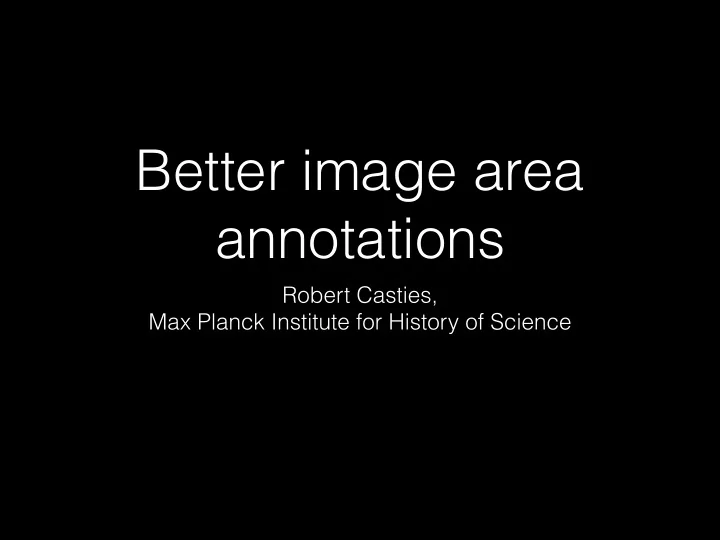

Better image area annotations Robert Casties, Max Planck Institute for History of Science
What we do • Work with historical sources • scanned books, manuscripts, notebooks • digital photos • scanned drawings and paintings • digital texts • data
Our vision • "Weaving a web of knowledge" (Jürgen Renn) • close and distant reading of all kinds of sources • create comments, relations, narratives • share the results during the process or the result with collaborators or everybody • collecting annotations on a source creates a "semantic network" of sources
What we want now • Right now • annotate resolution-independent images • annotate points, rectangular and non-rectangular image regions • but also • annotation of relations • rich and reliable provenance information
Status quo of image annotation standards <urn:uuid:40F2B17E-7CA2-42C2> a oa:FragmentSelector ; rdf:value "xywh=135,16,25,53" . • too simple • only rectangles along axes • only pixel or (integer) percent units
Status quo of image annotation standards <2752261a-d14b-11e1-b9b2-00163e110825> a oa:SvgSelector, ct:ContentAsText; dcterms:format "image/svg"; ct:chars """ <?xml version="1.0" standalone="no"?> <polygon xmlns="http://www.w3.org/2000/svg" points="5315,5639 5444,5529 5505,5593 5346,5691 5315,5639" /> """ . • too complicated • needs XML parser • many ways to describe the same geometry and coordinate system • many other features not related to defining areas
Proposal: fractional relative coordinates • Resolution-independent image using scaling image server • x and y as decimal fraction 0 ≤ x ≤ 1 of image width / height • can be used in media fragments: #xywh=fraction: 0.3333,0.5,0.1,0.31 • resolution depends on decimal precision • does not conserve angles and areas
Proposal: fractional relative coordinates • Advantages of relative coordinates • allows the client to use smaller image • saves round trip to server • enables resolution upgrades on the server
Proposal: WKT / GeoJSON for image areas • WKT / Simple Feature Access: plaintext geometry language, GeoJSON: JSON version • geometric primitives: point, line, polygon • only point coordinates • different geographic Coordinate Reference Systems (add fractional relative coordinates?)
Open questions • Use WKT plain text in OAC selector? • use GeoJSON in OAC selector? • more structured selector? • integration of GeoJSON in Annotator.js format?
Recommend
More recommend